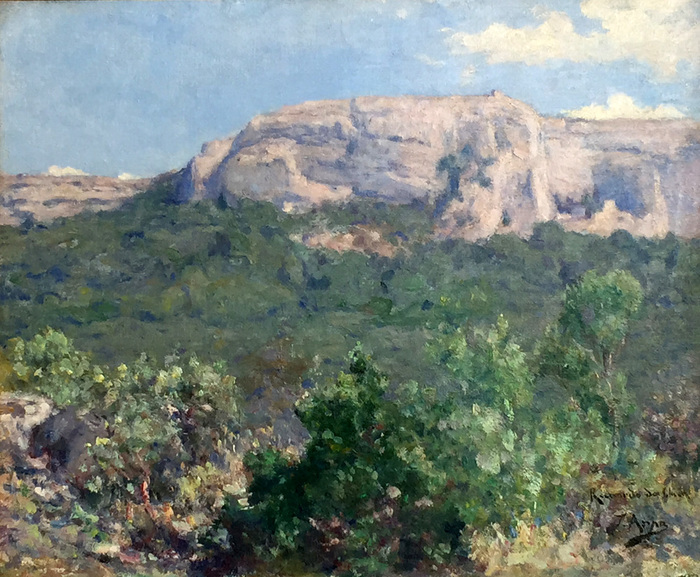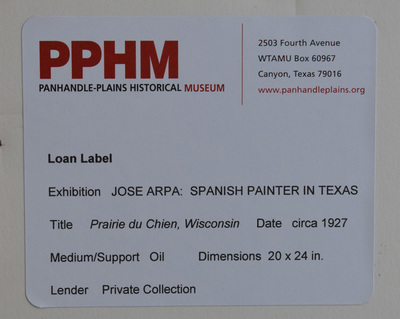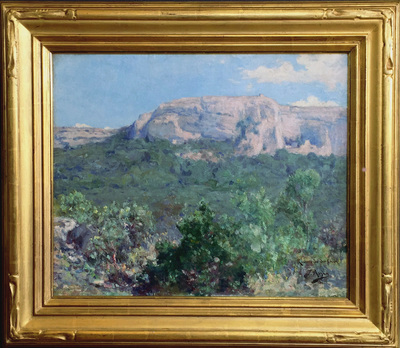Jose Arpa "Requerdo Du Chien" Recollections of Du Chien, Wisconsin
-
- Jose Arpa
- (1858-1952)
- San Antonio Artist
- Image Size: 20 x 24
- Frame Size: 27.5 x 31.5
- Medium: Oil
- Circa 1927
- "Requerdo Du Chien" Recollections of Du Chien, Wisconsin
- Contact for Price & Info
- View All By This Artist
Details
This painting was exhibited in 2010 at Harry Halff's Jose Arpa Show. Exhibition tag on verso.
It was also exhibited in 2016-2017 at Several Texas Museums including the Panhandle Plains Museum. Exhibition tag on verso.
There are several known paintings by Arpa of the Du Chien Wisconsin area. Records indicate he was there in 1912.
Mex MXX -
-
Biography
Jose Arpa (1858-1952)
Born in Carmona, Spain, José Arpa y Perea was known as "The Colorist Painter" of figures and landscapes, especially in Texas where he brought a fresh approach to San Antonio painting in his bright, sunlit local scenes. He was also an etcher, illustrator, and muralist as well as an art teacher, and he started and ended his career in Spain. His subjects include the Grand Canyon of Arizona.He began his art study as the pupil of Eduardo Cano de la Pena at the Academy of Fine Arts in Seville and then spent six years in Rome followed by extensive travel through Africa and Europe. His reputation was solid enough that the Spanish government sent four of his paintings as part of the exhibition to the 1893 World's Columbian Exposition in Chicago.In 1894, as an illustrator, he accompanied a Spanish army expedition to Morocco where the Spanish had been defeated by Rifi tribesmen. In the mid-1890s, he was brought to Mexico City, reportedly by a special Mexican naval vessel, to head the Academy of Fine Arts, but declined the position once he understood the responsibilities. Instead he joined one of his Spanish schoolmates and went to his home in Puebla, Mexico, where his use of bright colors earned him the name of "Sunshine Man." He became close to the children of this man, and in 1903, accompanied them as a guardian to school in San Antonio.After twenty years of traveling in Spain, Mexico, the Southwest, and South America, Arpa settled in 1923 in San Antonio, Texas, where he became Director of the San Antonio Art School and painted bright, sun-filled landscapes. He taught landscape and portrait painting and was exceedingly prolific, and several San Antonio collectors accumulated large numbers of his works. Among his close artist friends were Robert and Julian Onderdonk, Tom and Joe Brown, and Charles Simmang. They were members of a San Antonio group who painted together and called themselves the "Brass Mug Club."In 1932, he returned to Seville where he stayed for the next twenty years until his death, reportedly at age ninety-four.Source:Harold and Peggy Samuels, Encyclopedia of Artists of the American WestJohn and Deborah Powers, Texas Painters, Sculptors, and Graphic ArtistsInvited to direct the Academy of Fine Arts at Mexico City in 1893, Jose Arpa opened a studio at San Antonio, Texas, around 1901 and became an important part of the San Antonio school.Arpa studied at the School of Fine Arts in Seville, Spain, and received acclaim at the World's Columbian Exposition in Chicago in 1893. He returned to Spain in 1932.Arpa’s work is found in the San Antonio Museum of Art and the Witte Museum; and the Panhandle-Plains Historical Museum, Canyon.





